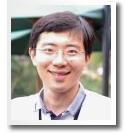Tutoriais
Tutorial 1 - Online Social Network and Cyber Security

- Apresentador: Prof. Felix Wu (University of California - Davis, EUA)
- Resumo: This tutorial will cover subjects such as OSN, Complex Network models, privacy and security, and its applications.
- Biografia: Prof. Felix Wu received his BS from Tunghai University, Taiwan in 1985, MS., and Ph.D. from Columbia University in 1989 and 1995 respectively, all in Computer Science. He is currently a Professor of Computer Science at University of California at Davis, and doing “experimental” research, i.e., building prototype systems to justify and validate novel architectural concepts. He and his students have built many experimental systems in the areas of fault tolerant network, IPSec/VPN security policy, attack source tracing, wireless network security, intrusion detection and response, unknown vulnerability analysis, email spam, information visualization for security, anomaly analysis and explanation. At one point in his career, he realized that he was probably interested in too many things though. Therefore, his latest focus has been on the DSL (Davis Social Links) project, which is currently being sponsored by NSF, DoD, Intel, and ETRI. Prof. Wu has served as a program committee member, an area editor, and a panelist, for many conferences, journals, and funding agencies. He was the program committee co-chair and currently serving in the steering committee for RAID (Symposium on Recent Advances in Intrusion Detection). He was the program chair for DSOM 2004 and IPOM 2007 both under IFIP/IEEE. Prof. Wu has published more than 85 research papers.
Tutorial 2 - Security and Privacy in Unattended Sensor Networks (or How to Cope with a Mobile Adversary)

- Apresentador: Prof. Gene Tsudik (University of California - Irvine, EUA)
- Resumo: Sensors and Wireless Sensor Networks (WSNs) have been very popular topics of research in the last decade. Commodity sensors' limited resources (memory, CPU, battery power and bandwidth) present many interesting challenges, especially, in terms of security and privacy. A great body of work has been accumulated on the subject of WSN security, ranging from super-efficient key management to mitigation of various exotic attacks. One common and basic assumption in prior WSN security work has been the existence of an on-line authority (a base station or a sink) that oversees the network and collects data. However, emerging Wireless Sensor Network (WSN) scenarios preclude constant presence of, and supervision by, a centralized data collection point, i.e., a sink. In such a disconnected or "unattended" WSN setting, nodes must accumulate sensed data until it can be safely off-loaded to an "itinerant" sink. Furthermore, if the network operating environment is hostile, there is a very real danger of node and data compromise. The unattended nature of the network makes it an attractive target for attacks that aim to learn, erase or modify potentially valuable data collected by sensors. In this tutorial presentation, we argue that adversarial models and defense techniques used in prior sensor security research are unsuitable for the unattended WSN setting. We define a new and realistic adversarial model - a mobile WSN adversary - by taking into account special features of the unattended network environment. We show that, in the presence of a powerful mobile WSN adversary, securing data stored on unattended sensors presents some interesting challenges and opens up an exciting new line of research. We will present some preliminary research results and discuss a number of open problems.
- Biografia: Gene Tsudik is a Professor in the Department of Computer Science at the University of California, Irvine. He has been conducting research in internetworking, network security and applied cryptography since 1987. He obtained his PhD in Computer Science from USC in 1991 for research on firewalls and Internet access control. Before coming to UC Irvine in 2000, he was a Project Leader at IBM Zurich Research Laboratory (1991-1996) and USC Information Science Institute (1996-2000). Over the years, his research interests included: routing, firewalls, authentication, mobile networks, secure e-commerce, anonymity, group communication, digital signatures, key management, mobile ad hoc networks, as well as database privacy and secure storage. Between 2003 and 2007, Professor Tsudik was the Associate Dean of Research and Graduate Studies in the School of Information and Computer Sciences at UCI. He spent April-September 2007 in Italy as a Fulbright Scholar lecturing and conducting research at the Universita' di Roma (La Sapienza). He is currently serving as the Director of Secure Computing and Networking Center (SCONCE) at UCI and the Vice-Chair for Graduate Studies in the Computer Science Department.
Tutorial 3 - Implementing Pairing-Based Protocols

- Apresentador: Prof. Alfred Menezes (University of Waterloo, Canadá)
- Resumo: In recent years, bilinear pairings have been used to design ingenious protocols for various tasks including identity-based encryption, homomorphic encryption, group signatures, and non-interactive zero-knowledge proof systems. Researchers have also made many discoveries that have dramatically improved the efficiency of these protocols. This tutorial will cover efficiency and security issues when implementing pairing-based protocols. For concreteness, the presentation will focus on the software implementation of pairing-based signature schemes due to Boneh-Lynn-Shacham and Waters, and their aggregation signature scheme counterparts, using Barreto-Naehrig elliptic curves. The first part of the tutorial will provide an introduction to pairings, the signature schemes, and their security proofs. The second part of the tutorial will delve into the details of implementing pairings and the signature schemes.
- Biografia: Alfred Menezes is a professor in the Department of Combinatorics and Optimization at the University of Waterloo, in Ontario, Canada, where he also serves as managing director of the Centre for Applied Cryptographic Research. His research interests are in curve-based cryptography, key agreement protocols, provable security, and algorithmic number theory. He is co-author of the "Handbook of Applied Cryptography" and "Guide to Elliptic Curve Cryptography".

© SBSeg´08. Todos os direitos reservados. ISBN 978-85-7669-190-7



